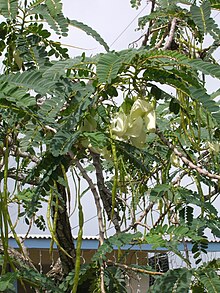This article needs additional citations for verification. (November 2024) |
| Sesbania grandiflora | |
|---|---|

| |
| Scientific classification | |
| Kingdom: | Plantae |
| Clade: | Tracheophytes |
| Clade: | Angiosperms |
| Clade: | Eudicots |
| Clade: | Rosids |
| Order: | Fabales |
| Family: | Fabaceae |
| Subfamily: | Faboideae |
| Clade: | Robinioids |
| Tribe: | Sesbanieae |
| Genus: | Sesbania |
| Species: | S. grandiflora
|
| Binomial name | |
| Sesbania grandiflora | |
| Synonyms[1] | |
| |
Sesbania grandiflora, common names vegetable hummingbird,[2] katurai, agati, and West Indian pea, is a leguminous tree of family Fabaceae native to Maritime Southeast Asia and Northern Australia. The flowers are eaten in Southeast and South Asia.
- ^ a b "Sesbania grandiflora (L.) Poir". Plants of the World Online. Royal Botanic Gardens, Kew. 2024. Retrieved 14 November 2024.
- ^ NRCS. "Sesbania grandiflora". PLANTS Database. United States Department of Agriculture (USDA). Retrieved 10 November 2015.